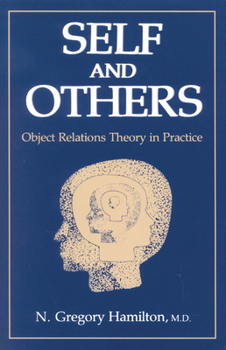Self and Others: Object Relations Theory in Practice
Select Format
Select Condition 
Book Overview
Self and Others is addressed to students and practitioners of psychoanalysis and psychoanalytic psychotherapy. Its 19 chapters are divided into five evenly balanced parts. The first rubric, "Self, Others, and Ego," introduces us to the units of the intersubjective constitution we have come to know as object relations theory. The second rubric, "Developing Object Relations," is a confluence of lessons derived from infant studies and the psychotherapeutic process, specifically from the work of Mahler and Kernberg. Third, Hamilton integrates into an "Object Relations Continuum" Mahler's developmental stages and organizational series with nosological entities and levels of personality organization. Under the penultimate rubric, "Treatment," levels of object relatedness and types of psychopathology are grounded in considerations of technique in treatment, and generous clinical vignettes are provided to illustrate the technical issues cited. Last, the rubric of "Broader Contexts" takes object relations theory out of the consulting room into application areas that include folklore, myth, and transformative themes on the self, small and large groups, applications of object relations theory outside psychoanalysis, and the evolutionary history and politics of object relations theory. This volume thus presents an integrative theory of object relations that links theory with practice. But, more than that, Hamilton accomplishes his objective of delineating an integrative theory that is quite free of rivalry between schools of thought. An indispensable contribution to beginning psychoanalytic candidates and other practitioners as well as those who wish to see the application of object relations theories to fields outside of psychoanalysis. --Psychoanalytic Books: A Quarterly Journal of Reviews A Jason Aronson Book
Format:Paperback
Language:English
ISBN:0876685440
ISBN13:9780876685440
Release Date:November 1999
Publisher:Jason Aronson
Length:352 Pages
Weight:1.11 lbs.
Dimensions:0.9" x 6.0" x 9.1"
Customer Reviews
2 ratings
Dig: Reality is Relatedness, Man.
Published by Thriftbooks.com User , 19 years ago
Dr. Hamilton's "Self and Others" is a wonderful book, very helpful for beginning therapists. Dr. Hamilton (or, may I call you "N. Gregory?") bridges ego psychology and self psychology to give an understandable overview of object relations. I like the approach of not getting bogged down in the inter-paradigmatic debates, but just pulling bits and pieces from disparate models and fitting them together into a developmental scaffolding. The book starts with an overview of self, object, and ego. Part 2 provides a nice summary of individual development, from birth, separation-individuation, to object constancy. We next get a comprehensive but clear run-through of the psychological mechanism involved, such as integration, projection, incorporation, and the inherently convoluted projective identification. Part three describes the object relations continuum, still referencing descriptive diagnoses by recognizable labels but conceptualizing these as constellations of symptoms that correlate with deficiencies in specific early developmental tasks (psychotic organization originating as far back as autistic stages, borderline personality organization stemming from rapprochement, and neurotic personality organization being tied in to whole object relations). A little dense, but overall it is understandable without feeling oversimplified. Hamilton is also careful not to be too rigid with the schema. He doesn't overstate the model, he doesn't deny the complexity of the dynamics involved, doesn't assert causation to the point of being deterministic. The chapter on narcissistic personality disorder is particularly important in this modern pseudo-capitalist oligarchy we live in, which fosters plenty of narcissism in all of us. (No, not you.) Part 4 focuses on treatment, linking object relations theory to the actual clinical practice, with chapters on technique, countertransference, groups, systems, and parallel processes. Part 5 gets a little trippy, exploring object relations in broader contexts such as folklore, myths, reality vs. unreality, out-of-body experiences and hypnotism. Overall, 5 stars, two thumbs up, an important book. It's not a quick read but it is a worthy one. If I had to nitpick and try to be critical, I might say that it always seems odd to me when authors reference themselves, cite their own work in a passage (speaking of narcissistic personality styles). At first glance one assumes it is a reference to supporting literature, a sign of a well-researched monograph. But when you think about it, it just means the author still agrees with something they wrote at an earlier time. Also, check out some of the prose. Here's a description of the infant in the autistic first two months of life: "They seem to live in a world of light and color, warm and cold, pain and pleasure, loud and quiet, still and moved. This world, it appears, is not divided into sets of opposites as is this description, which is divided thus because of
Object Relations
Published by Thriftbooks.com User , 24 years ago
It is an excellent book. A very thorough resource on Object Relations theory and its application to counseling. It is readable and explains the theory in a meaningful and helpful way. It's a great resource for graduate students and counselors of any age and experience!





